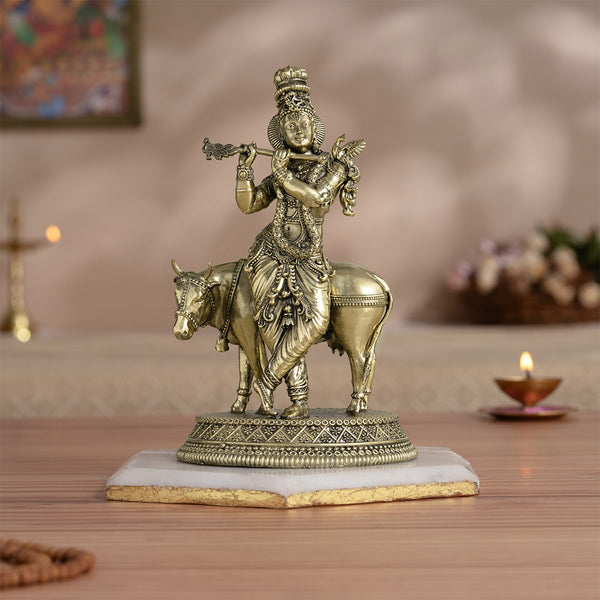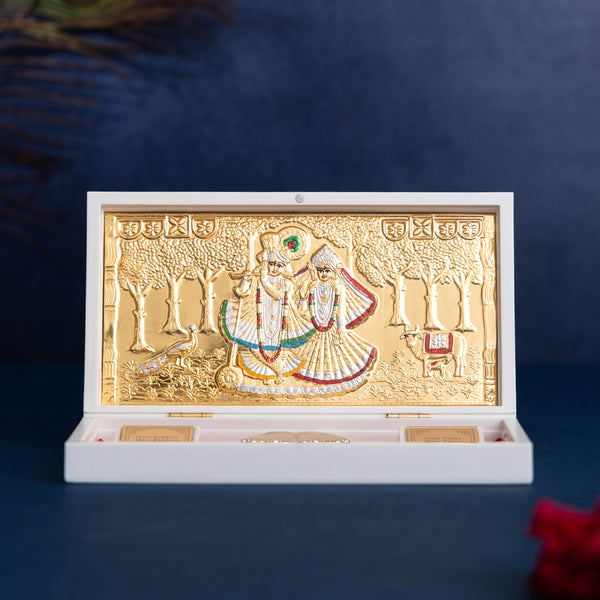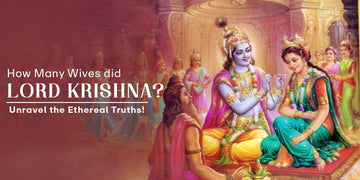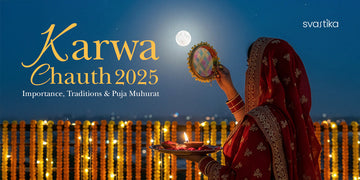Lord Krishna might arguably be the most loved and talked about deity in our Hindu culture.
Growing up Hindu, we have heard stories of our beloved and powerful deities who bring together the structure and foundation of our very universe.
The name Lord Krishna immediately brings to mind that of Radha alongside his. This is a boon awarded to Radham for her devotion and love.
Every story in the Krishna Leela shows the adventures and activities of Lord Krishna and Radha. Right from moving to Vrindavan, to be closer to his love, the story of Krishna and Radha is legendary and also inspiring couples even today, making a Radha Krishna gift for marriage a meaningful symbol of eternal devotion.
However, it was Goddess Rukmani that Lord Krishna is known to have wed. Apart from this, legend also talks about the several wives of Lord Krishna.
This celestial narrative has been the subject of intense fascination and curiosity, prompting us to delve deeper into the ancient texts and unravel the celestial truths.
In this article, we are exploring the life of Lord Krishna, his story of love, and his marital affairs.
For those seeking to connect more deeply with Lord Krishna's divine energy, bringing a Krishna idols into one's home can be a profound spiritual practice.
Many devotees find that the presence of a Krishna idol makes their space feel special. They believe it helps protect them and guide them in their everyday life.
Brass Standing Krishna Statue with Cow (7 Inch)
The Traditional Narrative of 16,108 Wives Of Lord Krishna
When people talk about Lord Krishna, a common topic that comes up is his 16,108 wives. This number often sparks curiosity and even mockery among those who don’t know the full story.
Yes, it’s a staggering number, but there’s more to it than meets the eye. Those who have delved deep into the Bhagavata Purana (Srimad Bhagavatam) understand the true context of Krishna’s life and actions.
The Srimad Bhagavatam is an extensive text detailing Krishna’s many adventures, known as Krishna Leela.

But before diving into these stories, it's important to grasp the essence of who Krishna is. Reading the philosophical discussions in the Bhagavad Gita and the Srimad Bhagavatam helps set the stage.
Jumping straight into the middle without this understanding can lead to confusion.
Krishna, the chief of the Yadavas in Dwarka, didn’t start with 16,108 wives.
In fact, he initially had eight, which was a common practice of polygamy back then. His eight wives were Rukmini, Satyabhama, Jambavati, Nagnajiti, Kalindi, Mitravinda, Bhadra, and Lakshmana.
Now, let’s talk about the story behind the 16,100 additional wives. It begins with a powerful asura (demon) king named Narakasura, who ruled Pragjyotishpur.
Naraka, the son of Bhudevi (Goddess Earth) and Varaha (an incarnation of Lord Vishnu), inherited divine powers but turned evil, especially after teaming up with another demon named Banasura.
Naraka’s power was so great that he captured numerous kingdoms and even made the gods in Swarga loka (heaven) flee.
Narakasura’s reign of terror extended to capturing 16,100 women from these defeated kingdoms.
When Goddess Aditi sought help from Satyabhama, Krishna’s wife, Satyabhama was furious. She convinced Krishna to attack Narakasura.
Riding on Garuda, Krishna and Satyabhama waged war against Naraka.
Krishna defeated Naraka’s general, Mura, earning the name ‘Murāri’ (enemy of Mura), while Satyabhama, an incarnation of Bhudevi, ultimately killed Narakasura with her arrow.

After Narakasura’s defeat, Krishna freed the 16,100 women.
However, these women, captivated by Krishna’s divine beauty, all vowed to either marry him or end their lives.
To restore their honor and elevate their societal status to queens, Krishna married them. This noble act explains why Krishna had 16,100 additional wives.
So, when you hear about Krishna’s 16,108 wives, remember the deeper story of nobility and honor behind it.
The Eight Principal Wives : The Ashta Bharya of Lord Krishna
The sacred texts highlight the unique roles of Lord Krishna’s eight principal wives (Ashtabharya) : Rukmini, Satyabhama, Jambavati, Kalindi, Mitravinda, Nagnajiti, Bhadra, and Lakshmana.
Each wife represents different virtues, embodying divine feminine energy (Shakti). Together, they symbolize the harmonious integration of these qualities in the spiritual journey.

Here are Krishna's eight main wives and their unique stories :
Rukmini :
Rukmini, the chief queen, was deeply in love with Krishna.
Despite her brother Rukmi arranging her marriage to his friend Shishupala, Rukmini sent a message to Krishna, asking him to rescue her.
Krishna swooped in during the wedding preparations, and with the help of his brother Balarama, defeated Rukmi and the other kings who pursued them.
Satyabhama :
Satyabhama, Krishna’s second wife, is considered an aspect of the earth goddess Bhudevi.
She achieved this divine status through intense meditation and penance, seeking refuge in Lord Vishnu's abode, Vaikuntha.
Impressed by her devotion, love, and care, Vishnu promised she would be his wife in his next incarnation.
Jambavati :
Jambavati’s story is quite unique. Her father, Jambavan, was a devotee of Lord Rama.
After surrendering to Krishna, Jambavan gifted his daughter to Krishna, forming this divine union.
Kalindi :
Kalindi was the keeper of the River Yamuna and the daughter of the Sun deity. She went into a deep trance, desiring to marry Lord Vishnu.
Seeing her true devotion, Krishna, an incarnation of Vishnu, fulfilled her wish.
Mitravinda :
Mitravinda was the daughter of King Jayasena of Avanti and his wife Rajadhidevi, who was the sister of Krishna’s father Vasudeva.
This makes her Krishna’s first cousin. Despite this family connection, her story stands out in its own right.
Nagnajiti :
Nagnajiti was the daughter of King Nagnajita of Kosala.
Krishna won her hand in marriage by participating in her swayamvara, where he successfully tamed seven ferocious bulls, as per the rules set by her father.
Bhadra :
Bhadra is often associated with the god of the hunt and is one of Shiva’s Ganas.
She was the daughter of King Bhadrasen and became Krishna’s seventh queen. She’s also linked with Mount Meru, adding a layer of mysticism to her story.
Lakshmana :
Lakshmana, mentioned in the Bhagavata Purana, was known for her good qualities.
She was the daughter of an unnamed ruler of the kingdom of Madra. Her story, though less detailed, is still significant in Krishna’s life.
These stories highlight not just the diverse backgrounds of Krishna's wives but also their deep connections to devotion, divine intervention, and unique circumstances.
Symbolic Interpretations and Spiritual Significance

The stories about Lord Krishna's many wives are often seen as rich in symbolism and spiritual meaning.
Instead of taking the number literally, many interpret the 16,108 wives as a representation of Krishna's infinite compassion and his embrace of all souls seeking liberation.
Some view this as a metaphor for Krishna's relationship with different aspects of creation and divine feminine energy.
Among his wives, the Ashtabharya, or eight principal wives, stand out. They are Rukmini, Satyabhama, Jambavati, Kalindi, Mitravinda, Nagnajiti, Bhadra, and Lakshmana.
Each of these women embodies one of the primary qualities associated with the divine feminine : love, devotion, knowledge, beauty, strength, patience, forgiveness, and detachment.
These wives recognized the divine essence within Krishna, seeing beyond his earthly appearance to his true nature.
If someone asks, “How many wives did Lord Krishna have?” or “Why did Krishna have so many wives?” you can explain the deeper significance.
Lord Krishna’s 16,108 wives symbolize his boundless compassion and divine connection with every soul.
The divine is beyond the ordinary human senses and free from desire, lust, and other vices that entangle humans in the cycle of birth and death.
The wandering sage Narada’s visit to Dwarka provides a fascinating glimpse into Lord Krishna's divine nature.
Narada, always curious and interested in others' affairs, arrived in Dwarka and wondered how Krishna managed to spend equal time with all 16,108 wives.
To his amazement, he found Krishna in each of his wives’ homes, perfectly performing the duties of a husband.
Convinced of Krishna’s divinity, Narada went on to spread the glory of Krishna around the world.
Another interesting angle is Krishna’s romance with the Gopis, the cowherdesses and companions of young Krishna. Sometimes, these Gopis are referred to as his 16,108 wives.

Krishna’s interactions with the Gopis are seen as a form of devotional worship. It is said that Krishna assumed over 16,000 forms simultaneously to be with all of them, showcasing his divine love and play.
There’s also a musical interpretation of Krishna’s wives. Krishna was an unparalleled flautist, and his music enchanted everyone around him.
The 16,108 wives are often compared to the 16,000 ragas or musical modes of Indian classical music.
In this view, Krishna is the Raga, and the female ragas or Raginis are his wives. Each Ragini chose a Raga and modulated her tunes to captivate Krishna’s heart, who is known for being blissful and harmonious.
Krishna, embodying music itself, embraced and enjoyed every variation, multiplied 16,000 times over!
Krishna's life is filled with Leelas, or divine plays, showcasing his miracles and reaffirming his divinity to humanity.
He transcends gender and caste, making his true home in the pure, unwavering hearts of his devotees.
The tales of Krishna's marriages are not just about numbers but about understanding his divine nature.
They remind us that the divine can manifest in numerous forms and relationships, always guiding us towards love, devotion, and spiritual growth.
Krishna's story is a testament to the limitless ways the divine can touch our lives and lead us towards enlightenment.
Svastika Radhe Krishna Pocket Temple - Gold Plated Shree Krishna's Charan Paduka (Lotus Feet) - Silver Plated (3 Inch)

Conclusion
The enigmatic stories of Lord Krishna's many marriages never fail to captivate and intrigue us.
Whether you take them literally or see them as metaphors, the underlying message is truly profound.
They highlight Krishna's boundless love, his embrace of all souls, and the beautiful balance between divine masculine and feminine energies.
These tales are more than just stories; they’re deep wells of spiritual wisdom and enlightenment.
They serve as powerful allegories that reflect the vastness of divine love and the harmonious interplay of all elements of creation.
In the end, it’s all about celebrating the divine love that permeates the universe.
Krishna’s narratives remind us of his eternal compassion and grace, showing us that his love and presence are always with us, guiding and nurturing our spiritual journey.








